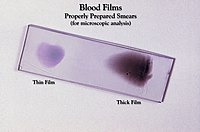
Photo from wikipedia
Since its development in the 1960s, flow cytometry (FCM) was quickly revealed a powerful tool to analyse cell populations in medical studies, yet, for many years, was almost exclusively used… Click to show full abstract
Since its development in the 1960s, flow cytometry (FCM) was quickly revealed a powerful tool to analyse cell populations in medical studies, yet, for many years, was almost exclusively used to analyse eukaryotic cells. Instrument and methodological limitations to distinguish genuine bacterial signals from the background, among other limitations, have hampered FCM applications in bacteriology. In recent years, thanks to the continuous development of FCM instruments and methods with a higher discriminatory capacity to detect low-size particles, FCM has emerged as an appealing technique to advance the study of microbes, with important applications in research, clinical and industrial settings. The capacity to rapidly enumerate and classify individual bacterial cells based on viability facilitates the monitoring of bacterial presence in foodstuffs or clinical samples, reducing the time needed to detect contamination or infectious processes. Besides, FCM has stood out as a valuable tool to advance the study of complex microbial communities, or microbiomes, that are very relevant in the context of human health, as well as to understand the interaction of bacterial and host cells. This review highlights current developments in, and future applications of, FCM in bacteriology, with a focus on those related to food and clinical microbiology.
Journal Title: Critical reviews in microbiology
Year Published: 2022
Link to full text (if available)
Share on Social Media: Sign Up to like & get
recommendations!